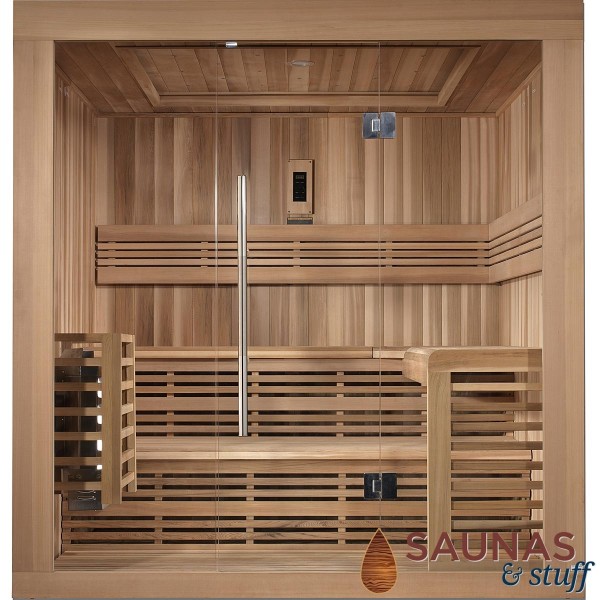All About Traditional Sauna
All About Traditional Sauna
Blog Article
The Only Guide for Traditional Sauna
Table of ContentsThe 30-Second Trick For Traditional SaunaGet This Report about Traditional SaunaHow Traditional Sauna can Save You Time, Stress, and Money.The 30-Second Trick For Traditional Sauna5 Easy Facts About Traditional Sauna Described
A lot of the weight lost in a sauna is water loss and is re-gained upon rehydrating. Without an uncertainty sauna can be a vital component of a healthy and balanced weight loss program. To look at the distinctions in between traditional and IR saunas, I will certainly divide these right into proven, academic, and made differences.Thus, the hottest point in the saunawhich is at the ceiling straight over the sauna heateris commonly in between 185 and 190 F. Claims that a traditional sauna exceeds 200 F is merely not real and not suitable for electrical saunas sold in the US. The temperature for a far-infrared sauna is typically set in between 120 and 140 F; however, unlike the typical sauna, the objective in and IR area is not to accomplish a heat.

When a traditional sauna has actually been correctly warmed, the sauna walls are cozy, the air temperature has actually achieved established temperature and the rocks are extremely heated. As an intriguing side note, the heated wall surfaces and the rocks are producing far-infrared warmth, integrated with the heated air, to produce an "wrapping up heat".
Indicators on Traditional Sauna You Need To Know
When the high temperature is accomplished, the components cycle on and off to maintain the high temperature level. Most conventional sauna customers delight in putting water over the rocks to develop vapor to raise sauna humidity degrees. The advantages of putting water over the rocks consist of: making the area more comfortable, moistening the nasal flows, and permitting the usage of aromatherapy by blending important oils with the water.

When the power gets in the body, it creates the body temperature level to raise and inevitably leads to perspiration. In an infrared sauna it is necessary for the emitters/heaters to stay on practically continuously. Since there is no mass of rocks to retain warmth, the sauna will certainly cool down if the emitters shut off.
Traditional Sauna Fundamentals Explained
As mentioned over, the sauna bather in an infrared space wishes to place himself in front of running emitters to obtain maximum advantage from the warm. The heating time for both spaces can be very various, depending upon exactly how the spaces are utilized. For a typical sauna, a bather should permit 30-40 minutes for the area to achieve a wanted temperature and to properly pre-heat the rocks.

A well built sauna will generally accomplish a temperature level of 150-160 F in about 30-40 mins (Traditional Sauna). For hotter temperatures, the room may need to warm for a longer duration. When the room achieves established temperature, the heating system will certainly cycle on and off, usually running about 50% of the time. The protected wall surfaces and the warmed rocks will certainly keep the room hot and at steady temperature levels.
To some, 15 minutes was "lost" while the infrared power warmed the timber panels instead than heating a body, while others find a pre-heated room to be more comfortable and believe an elevated beginning temperature level is essential to begin sweating. The size of advised usage for each and every area is about the same (10-15 minutes per session); however, due to the reduced air temperatures and the capability to feel the effects of infrared heat faster than a conventional sauna, it is not uncommon for a person to invest a total amount of 20-30 mins in an infrared sauna.
The 7-Second Trick For Traditional Sauna

The average price per kWH of electricity in the U.S. is about $0.11, so a 4.5 kW heater will certainly set you back approximately $.50 to run for one hour, if the heating system runs continuously for one hour. Typically a sauna heater will run for 75% of the first hour and 50% of subsequent hours on given that the elements cycle once the set temperature level is attained.
A 2 person far-infrared room is typically literally smaller sized than a traditional sauna, typically regarding 4' x 4' or smaller sized. The IR heater is typically 1.5-1.7 kW using a 120 volt 15 amp plug-in service. Considering that the space can be made use of sooner than a sauna room, we will assume the space is made use of for to of an hour consisting of warm up time.
There is a seldom discussed difference in the social experience between the 2 areas. While our society has actually shed several of the social advantage of the standard sauna experience, it can be extremely socially satisfying (Traditional Sauna). From household time in the sauna, to heart-felt conversations with considerable others, to Website sauna partiesthe conventional sauna experience can result in intimate socializing
Unknown Facts About Traditional Sauna
A lot of higher end infrared spaces include colored light treatment, noise systems and full-glass fronts.
Report this page